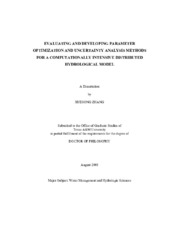| dc.contributor.advisor | Srinivasan, Raghavan | |
| dc.creator | Zhang, Xuesong | |
| dc.date.accessioned | 2010-01-15T00:11:48Z | |
| dc.date.accessioned | 2010-01-16T01:17:44Z | |
| dc.date.available | 2010-01-15T00:11:48Z | |
| dc.date.available | 2010-01-16T01:17:44Z | |
| dc.date.created | 2008-08 | |
| dc.date.issued | 2009-05-15 | |
| dc.identifier.uri | https://hdl.handle.net/1969.1/ETD-TAMU-3091 | |
| dc.description.abstract | This study focuses on developing and evaluating efficient and effective parameter
calibration and uncertainty methods for hydrologic modeling. Five single objective
optimization algorithms and six multi-objective optimization algorithms were tested for
automatic parameter calibration of the SWAT model. A new multi-objective
optimization method (Multi-objective Particle Swarm and Optimization & Genetic
Algorithms) that combines the strengths of different optimization algorithms was
proposed. Based on the evaluation of the performances of different algorithms on three
test cases, the new method consistently performed better than or close to the other
algorithms.
In order to save efforts of running the computationally intensive SWAT model,
support vector machine (SVM) was used as a surrogate to approximate the behavior of
SWAT. It was illustrated that combining SVM with Particle Swarm and Optimization
can save efforts for parameter calibration of SWAT. Further, SVM was used as a
surrogate to implement parameter uncertainty analysis fo SWAT. The results show that
SVM helped save more than 50% of runs of the computationally intensive SWAT model
The effect of model structure on the uncertainty estimation of streamflow simulation
was examined through applying SWAT and Neural Network models. The 95%
uncertainty intervals estimated by SWAT only include 20% of the observed data, while Neural Networks include more than 70%. This indicates the model structure is an
important source of uncertainty of hydrologic modeling and needs to be evaluated
carefully. Further exploitation of the effect of different treatments of the uncertainties of
model structures on hydrologic modeling was conducted through applying four types of
Bayesian Neural Networks. By considering uncertainty associated with model structure,
the Bayesian Neural Networks can provide more reasonable quantification of the
uncertainty of streamflow simulation. This study stresses the need for improving
understanding and quantifying methods of different uncertainty sources for effective
estimation of uncertainty of hydrologic simulation. | en |
| dc.format.medium | electronic | en |
| dc.format.mimetype | application/pdf | |
| dc.language.iso | en_US | |
| dc.subject | Parameter optimization | en |
| dc.subject | uncertainty analysis | en |
| dc.subject | hydrologic modeling | en |
| dc.subject | computational intensive | en |
| dc.title | Evaluating and developing parameter optimization and uncertainty analysis methods for a computationally intensive distributed hydrological model | en |
| dc.type | Book | en |
| dc.type | Thesis | en |
| thesis.degree.department | Forest Science | en |
| thesis.degree.discipline | Water Management and Hydrological Sciences | en |
| thesis.degree.grantor | Texas A&M University | en |
| thesis.degree.name | Doctor of Philosophy | en |
| thesis.degree.level | Doctoral | en |
| dc.contributor.committeeMember | Liang, Faming | |
| dc.contributor.committeeMember | Olivera, Francisco | |
| dc.contributor.committeeMember | Smith, Patricia K. | |
| dc.type.genre | Electronic Dissertation | en |
| dc.type.material | text | en |
| dc.format.digitalOrigin | born digital | en |


